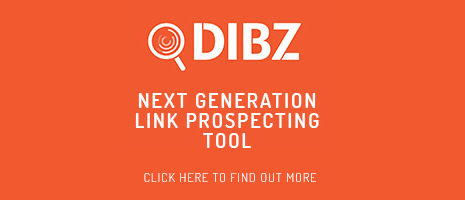Types and Purpose of Technical SEO Audits

One Line of Code – A Short Cautionary Tale
The phone call came mid-afternoon. Panic on the other end.
“We have zero organic traffic. Everything is gone.”
Here’s the context. This client had been ranking first position for the industry prime keyword – the one everybody in their space wants, the one competitors spend years chasing. First position. Bringing them a lot of money. The kind of organic traffic that actually converts.
They’d built a new website – prettier, faster, better structured, more awesome content. Everything is an upgrade. We were involved in the technical optimization of the new site during the dev phase, but not in migration consulting or the migration follow-up itself.
So when my phone rang with that panicked voice, my first question was simple: “Did you launch the new website?”
They confirmed. Launched it yesterday. Everybody tested it. Everybody was happy.
Next: “Did your developers remove the rel=noindex from the head before they deployed over the old website?”
They didn’t.
So here’s what happened. They launched this super cool, functional website. Team celebrated. But when Google’s next crawl hit – the crawler saw the noindex directive and did exactly what it was told. Google correctly concluded that this website doesn’t want to be indexed anymore and dumped the whole domain from the index.
Gone. Google can’t show your result if it doesn’t have it in the index.
The fix was simple. They removed noindex line from the head. Site got recrawled and re-indexed within a day. But here’s what still hurts: after reindex, Google dropped them to second position. And never put them back.
One line of code. For that industry prime bringing-the-majority-of-their-converting-traffic keyword – the difference between first and second position meant a lot, lot of money lost.
This shouldn’t happen. And it rarely happens. But it happens.
Website launches are stressful. Everybody is on edge. Whether it’s a robots.txt, or rel noindex left in place, or any of the ways you can block Google from crawling and indexing during development – due to stress and pressure, people simply forget to remove.
And that’s just one failure mode. When you launch a new website, somebody also needs to verify the redirects. If old URLs aren’t properly redirected to new ones, even if Google keeps indexing your site, you lose a ton of traffic anyway. All those pages that had SEO value from backlinks, page age, internal link structure – suddenly they’re 404s, or redirected to the homepage, which Google treats as a soft 404 anyway.
This guide breaks down three technical audit types – pre-migration, AI visibility, and development/launch – so you know which one fits your situation, when to run it, and exactly what breaks when you skip it.
Types and Purpose of Technical SEO Audits
If you’re planning a migration, gearing up for a new site launch, or noticing brand exclusion from AI answers, the right technical audit at the right time prevents expensive traffic loss and accelerates results. Most teams run a single catch-all “SEO audit” too late – after redirects go live, after Core Web Vitals regress, or after AI Overviews start omitting their brand – leading to crawl waste, indexation gaps, and months of recovery.
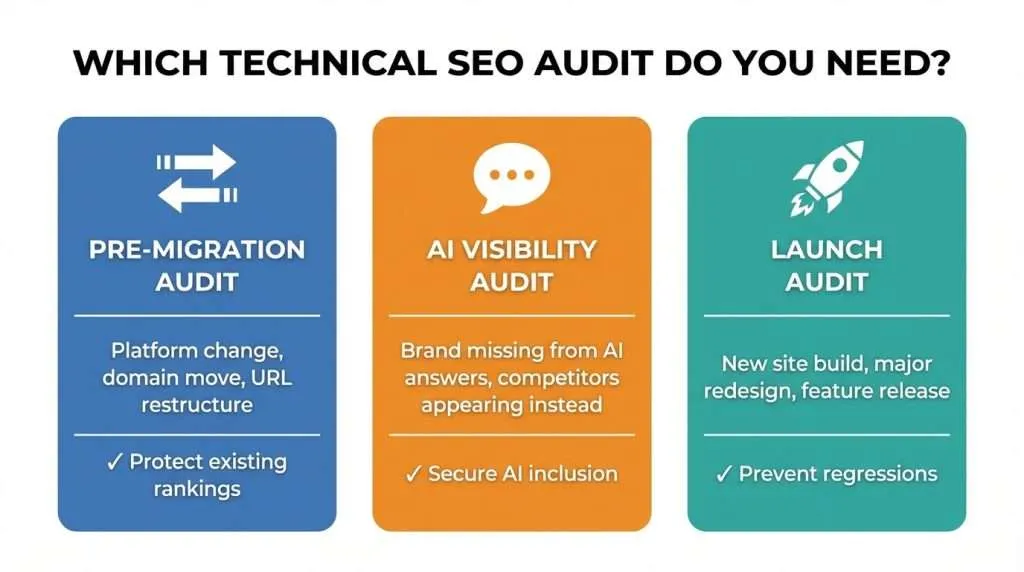
This guide clarifies three distinct audit types: pre-migration, AI visibility, and development/launch. You’ll learn what each delivers, when to run them, and exactly what can break if you don’t. Based on Four Dots’ 200+ point Enterprise Technical SEO Audit methodology, FAII AI visibility platform, and 13+ years executing for global brands including Orange and Coca-Cola.
The difference between a successful migration and a traffic disaster often comes down to timing. Running the wrong audit at the wrong time costs you rankings, revenue, and months of recovery work.
What Makes Technical SEO Audits Different
A technical SEO audit examines how search engines discover, crawl, render, and index your site. Unlike content audits that focus on keywords and messaging, technical audits diagnose infrastructure issues that block visibility regardless of content quality.
Technical audits cover seven core areas:
- Crawlability – Can search bots access and navigate your site efficiently
- Indexation – Are the right pages getting indexed and the wrong ones blocked
- Renderability – Can search engines execute JavaScript and see your content
- Site architecture – Does your URL structure and internal linking support discovery
- Performance – Do pages meet Core Web Vitals thresholds for speed and stability
- Structured data – Are schemas properly implemented for rich results and AI extraction
- Internationalization – Are hreflang tags and geo-targeting configured correctly
Why Timing Shapes Audit Scope
The same technical issues require different approaches based on when you discover them. A redirect mapping exercise before migration looks completely different from a post-launch indexation recovery effort.
Three distinct timing scenarios demand specialized audits:
- Pre-migration – Protect existing rankings and traffic during platform or domain changes
- AI visibility – Diagnose and fix brand exclusion from AI Overviews and LLM answers
- Development and launch – Prevent regressions from design through production deployment
Each audit type uses different diagnostic tools, involves different stakeholders, and delivers different implementation artifacts. Running a generic audit misses critical timing-specific risks.
Who Owns Technical SEO Audit Execution
Technical audits require coordination across multiple teams. Clear ownership prevents gaps and delays.
Typical stakeholder breakdown:
- Marketing/SEO – Define business goals, prioritize findings, manage vendor relationships
- Product – Approve scope changes, allocate sprint capacity, own launch decisions
- Engineering – Implement technical fixes, validate staging environments, deploy changes
- Analytics – Establish measurement baselines, configure tracking, validate data integrity
- QA – Test redirect mappings, verify schema deployment, run regression checks
Audit deliverables should match team workflows. Engineers need Jira-ready tickets with acceptance criteria. Marketing needs risk quantification tied to traffic and revenue impact. Product needs go/no-go decision frameworks with clear rollback procedures.
Pre-Migration Technical SEO Audit
Run this audit 3-8 weeks before moving platforms, changing domains, or restructuring site architecture. The goal is protecting existing search equity while enabling the new technical foundation to perform better than the old one.
A migration SEO audit inventories everything search engines currently value about your site, then maps how to preserve or improve those signals in the new environment. This includes URL structures, internal linking patterns, canonicalization rules, and structured data implementations.
What Pre-Migration Audits Deliver
The core deliverable is a redirect mapping file that matches old URLs to new URLs with 100% coverage of indexed pages. This file becomes the foundation for preserving rankings during the transition.
Complete pre-migration audit scope includes:
- Full URL inventory with traffic, rankings, and conversion data for prioritization
- Template-level analysis identifying which page types drive organic value
- Redirect mapping with parity checks for metadata, schema, and internal links
- Crawl budget optimization identifying faceted navigation bloat and parameter waste
- Core Web Vitals baseline with performance budget targets for new platform
- Structured data audit ensuring schema parity or improvements
- Hreflang mapping for international sites with geo-targeting verification
- Risk register quantifying traffic exposure by page type and timeline
- Go/no-go checklist with launch readiness criteria and rollback procedures
Deliverables arrive as engineer-ready specifications. Redirect mappings include source URLs, target URLs, redirect types (301 vs 302), and QA test cases. Robots.txt and sitemap configurations come with before/after comparisons and staging validation steps.
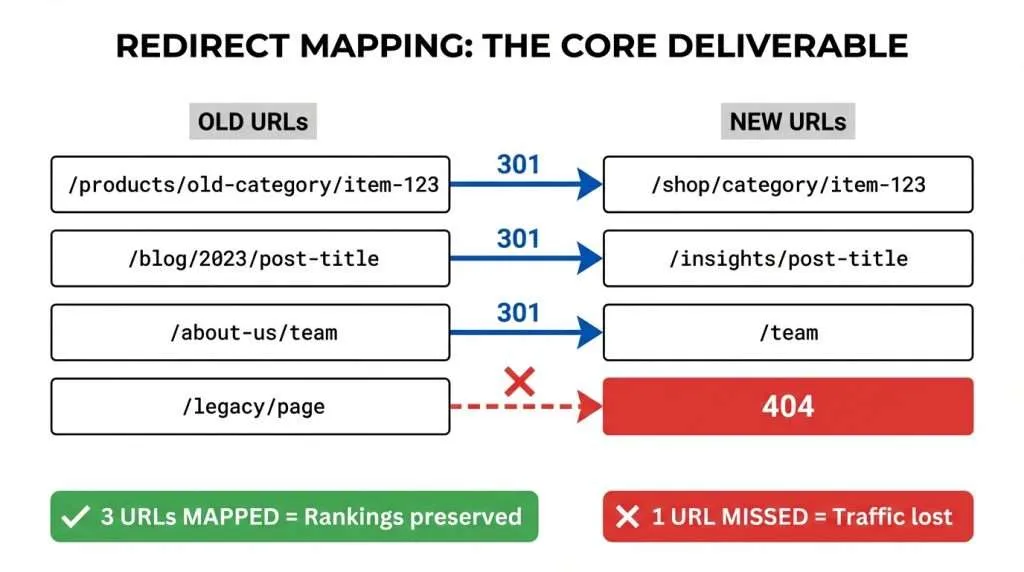
Tools and Signals for Migration Audits
Pre-migration diagnostics require both current-state and future-state analysis. You need to understand what’s working now and predict how changes will impact search visibility.
Essential data sources:
- Crawl data – JavaScript rendering checks, redirect chains, orphaned pages
- Log file analysis – Actual bot behavior, crawl budget allocation, discovery patterns
- Search Console – Index coverage, mobile usability, Core Web Vitals field data
- Analytics – Landing page performance, conversion paths, assisted conversions
- Performance monitoring – Lab and field data for page speed and interactivity
Log file analysis reveals crawl waste that redirect mappings alone won’t fix. If bots spend 60% of crawl budget on faceted navigation pages you plan to noindex, that pattern needs addressing before migration or the new site inherits the same inefficiency.
What Breaks When You Skip Migration Audits
The most common failure mode is incomplete redirect mapping. Teams map primary navigation and high-traffic pages but miss category filters, pagination sequences, or legacy URLs that still attract links and rankings.
Consequences of skipped or rushed migration audits:
- Redirect loops and chains – Rankings drop as bots hit redirect limits and abandon crawls
- Lost ranking pages – Unmapped URLs return 404s and lose positions within days
- Indexation waste – New site inherits crawl budget problems, delaying discovery of priority pages
- Canonical conflicts – Duplicate content issues emerge when canonicalization rules don’t migrate cleanly
- Hreflang breaks – International sites show wrong language versions, causing geo-targeting failures
- Schema regressions – Rich results disappear when structured data implementations don’t carry over
Recovery from migration failures typically takes 3-6 months and requires emergency redirect updates, indexation cleanup, and manual Search Console submissions. The cost in lost traffic and delayed projects far exceeds the investment in proper technical SEO audit services before launch.
Pre-Migration Go/No-Go Checklist
Use this checklist 48 hours before cutover to validate launch readiness. If any item fails, delay migration until resolved.
- Redirect file deployed and tested – Sample 50 URLs across templates, verify correct targets and response codes
- Robots.txt and sitemap updated – New rules allow bot access, sitemap contains only indexable URLs
- Canonical tags implemented – Self-referencing canonicals on indexable pages, cross-domain canonicals where needed
- Hreflang deployed – All language/region variants properly linked, x-default specified
- Schema validated – Structured data passes testing tools, covers priority page types
- Analytics tracking live – GA4 and Search Console connected, baseline data collecting
- Performance meets targets – Core Web Vitals pass field data thresholds on staging
- Internal links updated – Navigation and content links point to new URL structure
- Staging environment protected – Staging remains noindexed and/or authenticated; production controls verified; DNS ready
- Rollback plan documented – DNS revert procedure tested, backup redirect file ready
Document who verified each item and when. This creates accountability and provides audit trail if issues emerge post-launch.
AI Visibility Technical Audit
Run this audit when brand presence declines in AI Overviews or LLM responses, or before launching content that should appear in AI-generated answers. The goal is securing inclusion in the AI answer ecosystem that increasingly shapes how users discover and evaluate solutions.
An AI visibility SEO audit – also called a GEO audit for Generative Engine Optimization – diagnoses why AI systems exclude or misrepresent your brand. This differs from traditional technical audits by focusing on entity recognition, knowledge graph signals, and content formatting optimized for AI extraction rather than traditional search ranking factors.
What AI Visibility Audits Deliver
The core deliverable is a baseline report showing your brand’s inclusion share across major AI systems: ChatGPT, Google Gemini, Claude, Perplexity, and Google AI Overviews. This quantifies current visibility and tracks improvement over time.
Complete AI visibility audit scope includes:
- FAII baseline measurement – Inclusion percentage across AI platforms for brand and product queries
- Entity mapping – How AI systems understand your brand relationships and category positioning
- Knowledge graph analysis – Organization, Person, and Product schema implementation and consistency
- Content credibility audit – E-E-A-T signals, author bylines, citation patterns, source authority
- Structured data optimization – Schema types and properties that improve AI extraction
- Answer coverage gaps – Queries where competitors appear but your brand doesn’t
- Prompt space opportunities – Question patterns and topics where you should rank
- Implementation roadmap – Prioritized fixes with publish-amplify-measure loops
The FAII platform tracks your brand mentions across AI systems daily, alerting you to sudden drops in inclusion rates. This early warning system catches visibility problems before they impact traffic and conversions.
Tools and Signals for AI Visibility Audits
AI visibility diagnostics require different data sources than traditional technical audits. You’re measuring how AI systems extract and cite information rather than how search bots crawl and index pages.
Essential diagnostic tools:
- FAII platform – Automated tracking of brand inclusion across ChatGPT, Gemini, Claude, Perplexity, AI Overviews
- Schema validators – Verify Organization, Person, Product, FAQPage structured data
- Entity graph tools – Map how knowledge graphs connect your brand to related entities
- Citation analysis – Identify which sources AI systems reference for your category
- SERP feature tracking – Monitor AI Overview appearances for target queries
Citation patterns reveal why AI systems trust certain sources. If competitors appear consistently because they’re cited by authoritative industry publications, you need a strategy to earn similar citations rather than just optimizing on-site content.
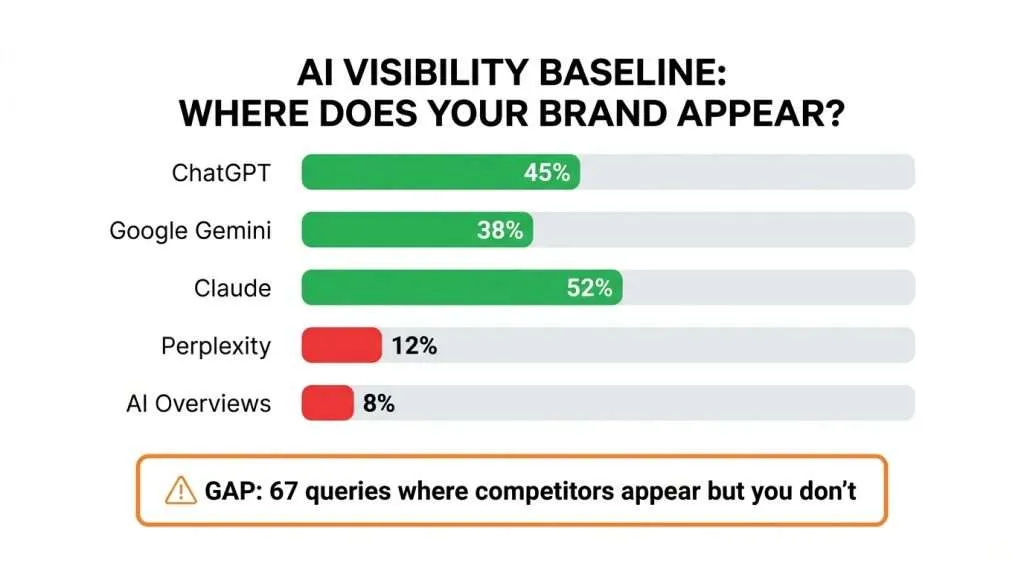
What Breaks When You Skip AI Visibility Audits
The most damaging failure mode is brand omission from AI-generated answers. Users asking about your category see competitor recommendations while your brand doesn’t appear, shifting traffic and conversions to alternatives.
Consequences of skipped AI visibility audits:
- Brand exclusion from AI answers – Lost visibility in the fastest-growing discovery channel
- Competitor advantage – Rivals capture AI-assisted traffic and conversions you should win
- Entity confusion – AI systems hallucinate wrong information about your brand or products
- Inconsistent representations – Different AI platforms show conflicting brand details
- Snippet eligibility loss – Content formatting prevents extraction for featured snippets and AI answers
- Knowledge graph gaps – Missing schema prevents AI systems from understanding brand relationships
Recovery requires systematic entity building, schema deployment, and content reformatting across your entire site. The work takes 2-4 months and competes with other priorities. Starting with an audit prevents the visibility loss in the first place.
AI Visibility Implementation Roadmap
Improving AI inclusion requires coordinated content, technical, and amplification work. This 90-day roadmap prioritizes high-impact fixes.
Days 1-30: Foundation and Quick Wins
- Deploy Organization and Person schema on priority pages
- Add author bylines with credentials to expertise-driven content
- Implement FAQPage schema on top-traffic articles
- Format content with clear headings and definition patterns AI systems extract
- Establish FAII baseline tracking for brand and product queries
Days 31-60: Entity Building and Content Optimization
- Build Product schema for key offerings with detailed properties
- Create comparison content answering common “best X” queries
- Optimize existing content for question-answer extraction
- Secure citations from industry publications AI systems reference
- Monitor FAII for inclusion rate changes and adjust tactics
Days 61-90: Scale and Measurement
- Expand schema coverage to secondary page types
- Launch content series targeting answer coverage gaps
- Build relationships with sources AI platforms cite frequently
- Establish monthly reporting on AI inclusion metrics
- Document what works and scale successful patterns
Track progress weekly using FAII inclusion percentages as the primary KPI. Supplement with traditional metrics like featured snippet wins and organic traffic from AI-heavy query patterns. Learn more about our AI SEO services for brand inclusion in AI answers.
Development and Launch Technical Audit
Run this audit from design and development sprints through soft launch and 7-30 days post-launch. The goal is preventing regressions that damage existing visibility while ensuring new features and pages achieve optimal search performance from day one.
A website launch SEO audit catches issues before they reach production. Staging environment problems cost hours to fix. Production problems cost traffic, rankings, and recovery time measured in weeks or months.
What Development and Launch Audits Deliver
The core deliverable is a launch-day runbook that QA teams use to verify every SEO-critical element before DNS cutover. This checklist prevents the most common launch failures: staging controls leaking to production, broken redirects, and template regressions.
Complete development and launch audit scope includes:
- Design-to-dev SEO requirements – Crawl rules, pagination patterns, parameter handling specs
- Environment controls – Noindex/nofollow for staging, authentication requirements, robots.txt rules
- Template-level specifications – Heading hierarchy, internal linking patterns, lazy loading configuration
- JavaScript rendering checks – Content visibility to bots, client-side routing, dynamic content
- Launch-day runbook – Step-by-step verification of redirects, DNS, HTTPS, schema, on-page parity
- Post-launch validation – Log monitoring, indexation tracking, Core Web Vitals, error budgets
- Regression monitoring – Automated checks for template changes, performance degradation, schema breaks
Template specifications include visual examples showing correct vs incorrect implementations. Engineers see exactly what heading structure, internal link placement, and schema markup should look like in production.
Tools and Signals for Launch Audits
Launch audits require comparing staging and production environments to catch differences before they impact users and search bots. Visual regression testing tools complement traditional crawlers and validators.
Essential diagnostic tools:
- Pre-production crawlers – JavaScript rendering, authentication handling, staging environment scanning
- Visual diff tools – Screenshot comparisons between staging and production templates
- Log monitoring – Real-time bot behavior tracking, crawl budget allocation, error patterns
- Search Console – Index coverage changes, mobile usability issues, Core Web Vitals regressions
- Performance monitors – Lighthouse CI, field data collection, regression alerting
Log file monitoring in the first 7-14 days post-launch catches issues traditional tools miss. If bots hit unexpected redirect chains or encounter server errors on specific templates, logs reveal the pattern before rankings drop.

What Breaks When You Skip Launch Audits
The most catastrophic failure mode is staging controls reaching production. A single noindex meta tag or robots.txt disallow rule can deindex your entire site within 48 hours.
Consequences of skipped development and launch audits:
- Staging noindex leaked to production – Complete deindexation within days
- Robots.txt blocking critical sections – Category pages or product templates excluded from crawling
- Broken sitemap submissions – Discovery delays for new pages and content
- Redirect mapping gaps – Old URLs return 404s instead of proper redirects
- Template regressions – Missing headings, broken internal links, schema deployment failures
- Core Web Vitals hits – Performance degradation from unoptimized assets or render-blocking resources
- Mobile usability breaks – Responsive design issues or touch target problems
Recovery requires emergency fixes during business-critical launch windows when engineering resources are stretched thin. The stress and coordination overhead far exceeds the cost of proper pre-launch validation. For complex implementations, consider advanced tracking and reporting implementation support.
Launch-Day QA Checklist
Use this checklist immediately after DNS cutover to verify production deployment. Complete all checks within the first 2 hours of launch.
- Robots.txt verification – Staging disallow rules removed, production rules allowing bot access
- Meta robots check – No noindex tags on indexable pages, nofollow removed from internal links
- Sitemap validation – XML sitemap accessible, contains only indexable URLs, submitted to Search Console
- Redirect testing – Sample old URLs redirect to correct new URLs with 301 status codes
- HTTPS enforcement – All pages serve over HTTPS, mixed content warnings resolved
- Canonical tags – Self-referencing canonicals on indexable pages, proper cross-domain canonicals
- Schema deployment – Structured data present on priority templates, validation errors resolved
- Internal linking – Navigation and content links use new URL structure, no broken links
- Mobile rendering – Pages display correctly on mobile devices, touch targets properly sized
- Core Web Vitals – Initial field data collection working, lab scores meet targets
- Analytics tracking – GA4 collecting data, Search Console showing crawl activity
- Error monitoring – 404 tracking enabled, server error alerting configured
Document findings with timestamps and screenshots. This creates an audit trail proving due diligence if post-launch issues emerge.
Choosing the Right Audit for Your Situation
The audit type you need depends on your timeline, business scenario, and risk profile. This decision matrix helps you select the right approach.
Audit Selection by Scenario
Match your current situation to the audit type that addresses your specific risks and timeline.
| Your Situation | Audit Type | Lead Time Needed | Primary Risk |
|---|---|---|---|
| Platform migration planned | Pre-Migration | 3-8 weeks before launch | Traffic loss from redirect failures |
| Domain change upcoming | Pre-Migration | 4-8 weeks before cutover | Ranking drops from URL changes |
| Brand missing from AI answers | AI Visibility | Start immediately | Competitor advantage in AI discovery |
| New site in development | Development & Launch | During build sprints | Launching with SEO blockers |
| Major redesign planned | Development & Launch | Design phase through launch | Template regressions hurting visibility |
| Content refresh initiative | AI Visibility | Before content production | Content not optimized for AI extraction |
Stakeholder Responsibility Matrix
Clear ownership prevents gaps and delays. This matrix shows who approves what for each audit type.
Pre-Migration Audit Stakeholders:
- SEO/Marketing – Approve redirect priorities, review traffic impact analysis, sign off on go/no-go
- Product – Allocate engineering capacity, approve timeline, own launch decision
- Engineering – Implement redirects, deploy technical fixes, validate staging environment
- QA – Test redirect mappings, verify schema deployment, run regression checks
- Analytics – Establish pre-migration baseline, configure tracking, validate data continuity
AI Visibility Audit Stakeholders:
- SEO/Marketing – Define target queries, prioritize content gaps, track FAII metrics
- Content – Implement formatting changes, add schema markup, optimize for extraction
- Engineering – Deploy structured data, implement entity schemas, configure monitoring
- PR/Communications – Secure citations, build relationships with authoritative sources
Launch Audit Stakeholders:
- Product – Approve SEO requirements, allocate sprint capacity, own launch timeline
- Engineering – Implement template specs, deploy launch-day fixes, monitor production
- QA – Execute launch checklist, verify environment controls, test redirects
- SEO/Marketing – Provide specifications, review staging environment, approve go-live
When to Run Multiple Audits
Some situations require layering different audit types. A platform migration for an e-commerce site might need both a pre-migration audit and a launch audit if you’re also redesigning templates.
Common multi-audit scenarios:
- Migration + redesign – Pre-migration audit for URL mapping, launch audit for template validation
- New site + AI focus – Launch audit for technical foundation, AI visibility audit for content strategy
- Replatform + international expansion – Pre-migration audit with enhanced hreflang analysis, launch audit for new geo-targeting
Coordinate timing so audits inform each other. Run the pre-migration audit first to establish redirect requirements, then use those findings in the launch audit checklist.
Audit Deliverables and Implementation Timelines
Technical audits deliver different artifacts based on type and scope. Understanding what you receive helps you plan implementation capacity and timeline.
Standard Audit Deliverables
Every technical audit includes these core components regardless of type:
- Executive summary – Business impact quantification, risk assessment, priority recommendations
- Technical findings report – Detailed diagnostics with screenshots, code examples, and severity ratings
- Implementation roadmap – Prioritized fixes with effort estimates and dependencies
- QA test cases – Acceptance criteria for validating each fix
- Measurement plan – KPIs and tracking setup for monitoring progress
Specialized Deliverables by Audit Type
Each audit type includes additional specialized outputs.
Watch this video about Types and Purpose of Technical SEO Audits:
Pre-Migration Audit Adds:
- Complete redirect mapping file (CSV with source, target, status code)
- Crawl budget analysis with waste quantification
- Performance baseline and targets for new platform
- Go/no-go checklist with launch readiness criteria
- Rollback procedure documentation
AI Visibility Audit Adds:
- FAII baseline report with inclusion percentages across AI platforms
- Entity mapping showing knowledge graph relationships
- Schema implementation guide for Organization, Person, Product
- Content formatting templates optimized for AI extraction
- Answer coverage gap analysis with competitor benchmarks
Development & Launch Audit Adds:
- Template-level specifications with visual examples
- Environment control checklist for staging vs production
- Launch-day runbook with step-by-step verification
- Post-launch monitoring dashboard configuration
- Regression testing automation setup
Implementation Timeline Expectations
Plan implementation capacity based on audit findings volume and complexity. These timelines assume dedicated engineering and SEO resources.
Pre-Migration Implementation: 4-12 Weeks
- Weeks 1-2: Deploy redirect file, fix critical crawl issues
- Weeks 3-4: Implement schema parity, optimize performance
- Weeks 5-6: QA testing, staging validation, final adjustments
- Weeks 7-8: Launch window, immediate post-launch monitoring
- Weeks 9-12: Indexation tracking, performance optimization, issue resolution
AI Visibility Implementation: 8-16 Weeks
- Weeks 1-4: Deploy foundational schemas, add author credentials, format priority content
- Weeks 5-8: Build entity relationships, secure citations, expand schema coverage
- Weeks 9-12: Launch content series targeting answer gaps, monitor FAII metrics
- Weeks 13-16: Scale successful patterns, establish ongoing measurement
Launch Audit Implementation: 2-6 Weeks
- Weeks 1-2: Implement template specifications during development sprints
- Weeks 3-4: Staging environment testing, fix identified issues
- Week 5: Launch-day execution, immediate validation
- Week 6: Post-launch monitoring, regression fixes, performance optimization
Timelines extend when findings reveal fundamental architecture problems requiring larger refactoring. Budget extra capacity for discovery work if you haven’t run technical audits recently.
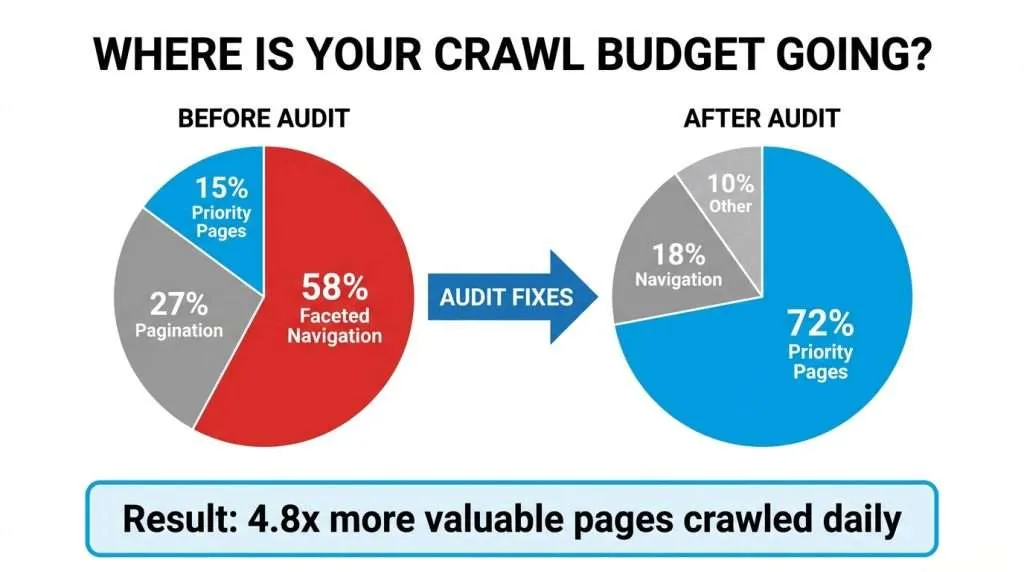
Measuring Audit Success and Ongoing Monitoring
Technical audits create value through implementation and measurement. Track these KPIs to quantify impact and justify continued investment.
Core Technical Health Metrics
Monitor these metrics weekly during implementation, then monthly for ongoing health checks:
- Crawl efficiency – Percentage of crawl budget spent on indexable pages vs waste
- Index coverage – Ratio of indexed pages to submitted pages, error rate trends
- Core Web Vitals – LCP, INP, CLS passing thresholds in field data
- Mobile usability – Issues reported in Search Console, page experience scores
- Schema validation – Structured data error count, rich result eligibility
- Redirect health – Chain length, 404 rate, redirect response time
Business Impact Metrics
Connect technical improvements to business outcomes to demonstrate ROI:
- Organic traffic – Sessions, users, and pageviews from organic search
- Rankings – Keyword position changes for priority terms
- Conversions – Goal completions and revenue from organic traffic
- Page speed impact – Bounce rate and conversion rate changes after CWV improvements
- Rich result wins – Featured snippets, knowledge panels, AI Overview inclusions
AI Visibility Tracking
For AI visibility audits, track brand inclusion across AI platforms as the primary success metric:
- FAII inclusion percentage – Brand mention rate across ChatGPT, Gemini, Claude, Perplexity, AI Overviews
- Answer coverage – Percentage of target queries where your brand appears in AI responses
- Entity accuracy – Correct vs incorrect brand information in AI-generated content
- Citation frequency – How often AI systems reference your content as a source
- Competitor displacement – Queries where you replaced competitor mentions
Establish baselines before implementation starts. Track changes weekly during active optimization, then monthly for ongoing monitoring.
Ongoing Audit Cadence
Technical SEO isn’t a one-time project. Sites evolve, search algorithms change, and new issues emerge. Establish a regular audit cadence based on your site’s complexity and change frequency.
Recommended Audit Frequency:
- Enterprise sites – Quarterly comprehensive audits, monthly spot checks
- E-commerce platforms – Bi-annual comprehensive audits, quarterly focused reviews
- Content sites – Annual comprehensive audits, quarterly performance reviews
- SaaS products – Audit with each major release, quarterly technical health checks
Trigger additional audits when major changes occur: platform migrations, redesigns, algorithm updates, or unexplained traffic drops. Review results from enterprise technical SEO audits to see typical outcomes and timelines.
Risk Quantification and Decision Frameworks
Technical audit recommendations compete with other priorities for engineering capacity. Quantifying risk helps stakeholders make informed decisions about timing and resource allocation.
Traffic Risk Assessment
Calculate potential traffic loss to prioritize fixes and justify investment. This framework estimates exposure based on issue severity and page importance.
Risk Calculation Formula:
Traffic at Risk = (Affected Pages × Average Traffic per Page) × Probability of Impact × Severity Factor
- Probability of Impact – 0.9 for critical issues (noindex, redirect failures), 0.5 for moderate issues (schema errors), 0.2 for minor issues (optimization opportunities)
- Severity Factor – 1.0 for complete visibility loss, 0.5 for ranking drops, 0.2 for rich result loss
Example: A migration with incomplete redirect mapping affecting 500 pages averaging 100 monthly visits each represents 45,000 sessions at risk (500 × 100 × 0.9 × 1.0). At a $50 customer acquisition cost, that’s $2.25M in marketing value at risk.
Implementation Effort vs Impact Matrix
Prioritize audit findings using a 2×2 matrix plotting implementation effort against business impact.
Quick Wins (Low Effort, High Impact):
- Fix critical redirect chains (2-4 hours)
- Deploy missing canonical tags (4-8 hours)
- Add Organization schema (2-4 hours)
- Remove staging noindex tags (1 hour)
Strategic Projects (High Effort, High Impact):
- Rebuild faceted navigation to reduce crawl waste (4-8 weeks)
- Implement comprehensive hreflang for international sites (6-12 weeks)
- Redesign site architecture for better crawl efficiency (8-16 weeks)
Fill-Ins (Low Effort, Low Impact):
- Optimize image alt text (ongoing)
- Add FAQ schema to blog posts (ongoing)
- Internal linking improvements (ongoing)
Backlog (High Effort, Low Impact):
- Migrate legacy blog platform (defer until strategic need)
- Rebuild custom CMS features (defer unless blocking)
Tackle quick wins immediately to build momentum. Schedule strategic projects based on available capacity and business timing. Defer backlog items unless they become blockers.
Go/No-Go Decision Framework
Use this framework to decide whether to proceed with launches or migrations when audit findings reveal issues.
Proceed if:
- Zero critical issues (noindex, redirect failures, complete template breaks)
- Moderate issues have documented workarounds and post-launch fix plans
- Risk assessment shows acceptable traffic exposure
- Rollback procedures tested and ready
- Post-launch monitoring configured and staffed
Delay if:
- Any critical issues remain unresolved
- Redirect mapping incomplete or untested
- Core Web Vitals significantly worse than current site
- Staging environment controls not validated
- No rollback plan or insufficient monitoring
Abort if:
- Fundamental architecture problems discovered too late to fix
- Risk assessment shows unacceptable traffic loss probability
- Engineering capacity insufficient for required fixes
- Business timing no longer supports launch window
Document the decision rationale and who approved proceeding despite known issues. This protects teams if problems emerge and provides learning for future projects.
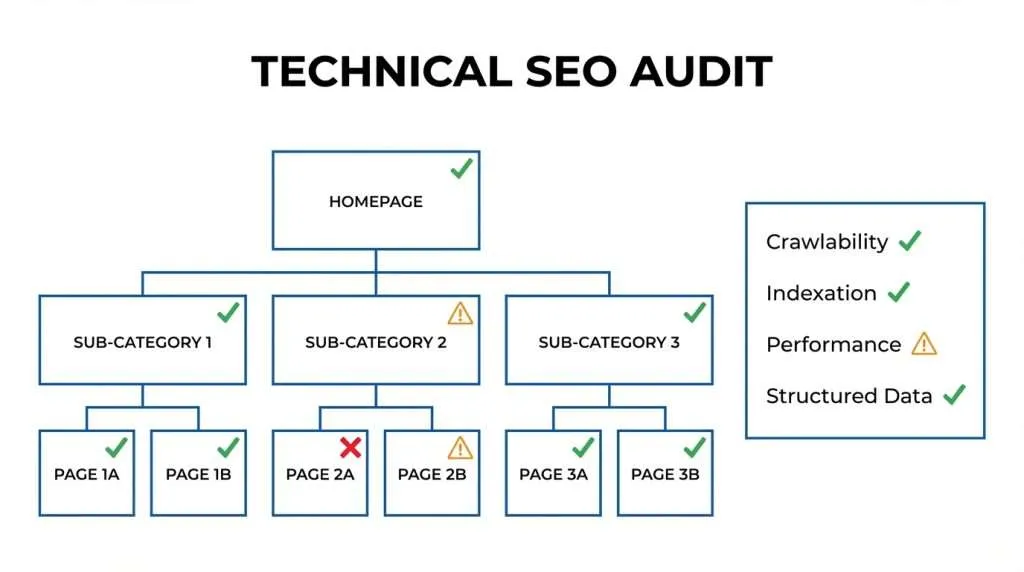
Agency and White-Label Considerations
Digital agencies delivering technical audits for clients need additional capabilities: white-label reporting, transparent workflows, and tools that scale across multiple client accounts.
White-Label Audit Delivery
Agencies require branded deliverables that present findings under their own identity. White-label audit platforms provide:
- Custom branding – Agency logo, colors, and formatting throughout reports
- Client portals – Secure access for clients to view findings and track progress
- Automated reporting – Scheduled updates on implementation status and KPI tracking
- Multi-client management – Centralized dashboard across all client accounts
Four Dots provides white-label SEO for agencies through proprietary platforms including Reportz.io for client reporting and Base.me for campaign management.
Capacity and Specialization Challenges
Many agencies lack in-house technical SEO specialists capable of executing enterprise-grade audits. Common gaps include:
- Log file analysis expertise – Understanding bot behavior and crawl budget optimization
- JavaScript rendering diagnostics – Troubleshooting client-side rendering and hydration issues
- International SEO complexity – Properly configuring hreflang and geo-targeting
- Enterprise-scale tooling – Access to crawlers and platforms handling millions of URLs
- Developer communication – Translating SEO requirements into engineering specifications
Partnering with specialized providers lets agencies offer comprehensive audits without hiring full-time technical SEO staff. This model provides capacity during peak demand and access to specialized expertise for complex projects.
Transparent Pricing and Scope
Agencies need predictable pricing to build audit services into client proposals. Four Dots publishes transparent pricing for standard audit types:
- Standard Technical Audit – $1,800 for sites up to 10,000 pages
- Enterprise Migration Audit – $3,900 for complex migrations with 50,000+ pages
- AI Visibility Baseline – Custom pricing based on query volume and platform coverage
This transparency eliminates proposal uncertainty and helps agencies price services competitively while maintaining margins.
Frequently Asked Questions
How long does a technical audit take to complete?
Standard audits typically take 1-2 weeks from kickoff to deliverable. Enterprise migration audits require 2-4 weeks due to redirect mapping complexity and stakeholder coordination. AI visibility audits take 2-3 weeks to establish baselines across multiple platforms and analyze entity relationships.
Can I run a technical audit on a site that’s already live?
Yes. Post-launch audits identify issues causing performance problems, traffic declines, or indexation gaps. While pre-launch audits prevent problems, post-launch audits diagnose and fix existing issues. The sooner you audit after noticing problems, the faster you can recover lost visibility.
Do I need a separate audit for mobile?
No. Modern technical audits include mobile-specific diagnostics as standard: mobile usability checks, responsive design validation, and mobile Core Web Vitals analysis. Mobile-first indexing means every audit must address mobile performance and user experience.
How often should I run technical audits?
Run comprehensive audits annually at minimum. Increase frequency based on site complexity and change rate: quarterly for enterprise sites with frequent updates, bi-annually for e-commerce platforms, and before any major migration or redesign regardless of schedule.
What’s the difference between a technical audit and a content audit?
Technical audits examine infrastructure: crawlability, indexation, performance, structured data, and site architecture. Content audits evaluate messaging, keyword targeting, content quality, and user engagement. Both are valuable but address different aspects of search visibility. Most comprehensive SEO programs include both audit types.
Can technical audits guarantee ranking improvements?
No audit guarantees specific rankings. Technical audits remove barriers preventing search engines from properly discovering, understanding, and ranking your content. Fixing technical issues creates the foundation for ranking improvements, but content quality, links, and competitive factors also influence rankings.
Do I need developer resources to implement audit findings?
Yes. Most technical audit recommendations require engineering implementation: redirect deployments, schema additions, performance optimizations, and architecture changes. Budget engineering capacity before commissioning audits to ensure findings get implemented rather than sitting in backlog.
How do I know if my site needs an AI visibility audit?
Run an AI visibility audit if you notice declining traffic from informational queries, competitors appearing in AI Overviews while you don’t, or your brand missing from ChatGPT and Gemini responses. Also audit before launching major content initiatives to ensure AI optimization from the start.
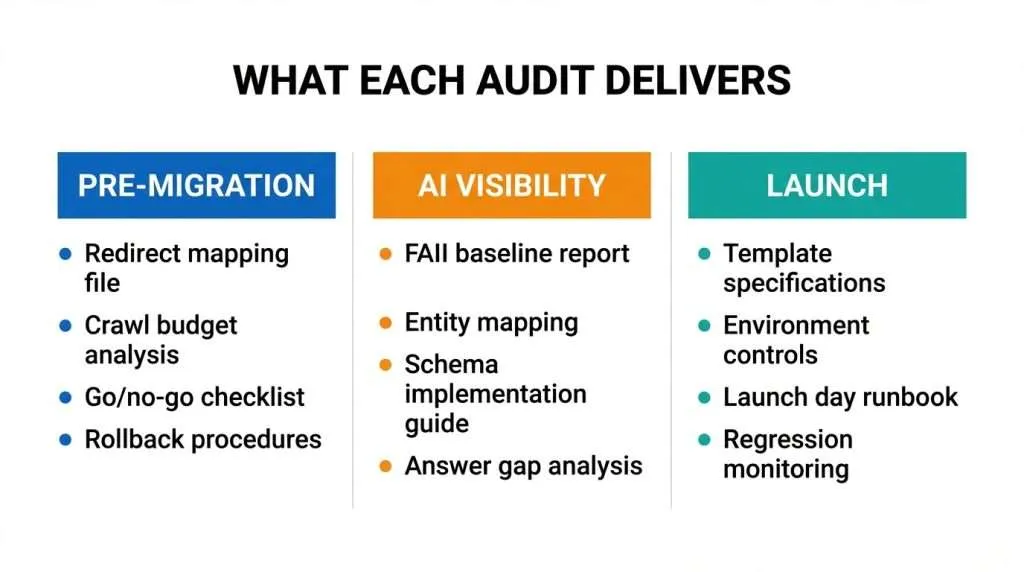
Taking Action on Technical SEO Audits
The right technical audit at the right time protects existing visibility while creating conditions for growth. Pre-migration audits prevent traffic loss during platform changes. AI visibility audits secure brand inclusion in the fastest-growing discovery channel. Development and launch audits catch regressions before they reach production.
Choose your audit type based on business timing and risk profile. Migrations and redesigns require pre-launch audits 3-8 weeks before cutover. AI visibility concerns demand immediate baseline assessment. New development projects benefit from continuous audit involvement from design through post-launch.
Key takeaways for audit success:
- Match audit type to your specific scenario and timeline
- Secure engineering capacity before commissioning audits
- Establish clear stakeholder ownership and decision frameworks
- Quantify traffic risk to prioritize implementation
- Monitor technical health metrics and business impact KPIs
- Maintain regular audit cadence based on site complexity
Technical SEO audits deliver ROI through prevented problems and accelerated results. The cost of a comprehensive audit is a fraction of the revenue loss from migration failures, indexation problems, or AI visibility gaps.
Review Four Dots’ 200+ point Enterprise Technical SEO Audit methodology and sample deliverables on the technical SEO audit services page. Get a custom audit proposal tailored to your migration timeline, AI visibility goals, or launch requirements.
Ready to proceed? Request an audit proposal or schedule a consultation.


 SEARCH
SEARCH